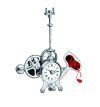| Contradiction
(I). |
 |
||
| The
supposed liaison of Claude Debussy and Camille
Claudel. |
|||
| How can one assert, without pieces of evidence, the liaison between a music genius and a gifted sculptoress, be believed, and published in a national newspaper ? | |||
To answer this, we will use a special issue of the Figaro (March 2008), devoted to Camille Claudel. |
|||
|
A supposition should be supported by facts, but in lack of
them,
you may need a touch of mystery. That fascinates and hides
rather
well a eventual absence of evidence. Considering Debussy's life, the
mystery already exists in a letter to his friend Robert Godet, telling
his desesperation about a broken relationship
: "when
so cruel words were falling from these lips, I heard in me the so
unique and lovable things they had told me ! and the notes out of tune
(real, alas!) offending those that were singing in me, tore me apart,
without my being able to really understand."
Robert Godet will be the only one to describe the link between Debussy
and Camille Claudel, in 1926 : "She
had for him a increasing curiosity [...] in the end, she was listening
to him reverently but with a silence that was far from resignation. And
the time came when she was heard to say, when the pianist left the
piano with chilly hands, leading him to the fireplace :"No
comment, Mister Debussy"."
In his article (La
musique intérieure),
Patrick de Bayser relates all this and says that Debussy and Camile
Claudel could have met at Henri Lerolle's house (Lerolle is a painter,
the brother-in-law of Ernest Chausson) or at Robert Godet's, who owned
two works of Camille Claudel, or else through Mallarmé (that
Debussy and Paul Claudel, Camille's brother, knew).Patrick de Bayser imagines that Camille "was attracted by an artist whose sensibility was close to hers", but that she chose to stay with Rodin, that she sacrificed to him this "love-to-be". The desesperation of Debussy is meant to be the result of the end of this relationship. The testimony of Godet was already known from Debussy's biographers as was his owning La valse. However, François Lesure writes : "All that has been written about
a liaison between [Debussy and Camille Claudel] is pure speculation"(2003).
According to him, it is no more than a legend that "is
based on [Godet]'s testimony, that never said such a thing. There is
not the least proof that the letter addressed on the 13th of February
1892 by Debussy to Godet and mentionning the end of an sentimental
affair, refered to C. Claudel [...]"(Claude Debussy. Biographie
critique, p.1557-458)
Jean-Michel Nectoux, in Harmonie en
bleu et or. Debussy, la musique et les arts (2005), don't believe either
in that supposition.The main thing written by Patrick de Bayser is... his title : "On the 15th of July 1889, Debussy and Camille Claudel went together to the Exposition Universelle, in order to listen to Javanese music." That was already mentioned by Nectoux but without the source of this claim. Patrick de Bayser do not give the source either.? If they really had gone toghether, the document proving it could contain interesting formulations, giving us a hint of their relation !.... I'm waiting desperately so if you are Patrick de Bayser, tell me everything here, and now ! |
La musique intérieure, Patrick de Bayser, p34, in the Figaro (special issue, March 2008) | ||
| The second article about a link between
Debussy and C. Claudel is due to Jean-Pierre Armengaud. It does not mention anything new on the biographical side of the issue. It just quotes a longer passage from Godet's letter and concludes peremptorily that the woman is doubtlessly Camille Claudel. Jean-Pierre Armengaud compares the letter to something near Beethoven's Heiligenstadt's testament (to that, I now agree but in an other way; besides, it's in Jean Baraqué's nice book upon Debussy) The article focuses on the similarities between Debusssy's and C. Claudel's works. |
Le silence de la mer, Jean-Pierre Armengaud, p85, in the Figaro (special issue, March 2008). | ||
|
Practical exercice : How can one contradict the precedent supposition ? One should state that : - the aesthetical comparison developped by J.-P. Armengaud, despite its artistic value, does not bring any piece of evidence to the initial hypothesis. - a common walk in the Exposition universelle, in July 1889, has to be more precisely documented, - but even if Debussy and C. Claudel had actually listened together to Javanese music, it does not imply that - they were closely linked, - that C. Claudel is the person pointed at in Debussy's letter to Godet, - that Godet, in 1942 when he decided to publish this letter, could have feared unwanted questions and chosen to focus on an artistic meaningful friendship, therehow suggesting a wrong track to the contemporaries. Here (in French), some excerpts of what Godet said in the foreword of Claude Debussy, lettres à deux amis (Corti, 1942). And here, more of this moving letter of Debussy to Godet. |
David Lamaze
Le Cygne de Ravel ~ Le Coeur de l'horloge
Le Cygne de Ravel ~ Le Coeur de l'horloge